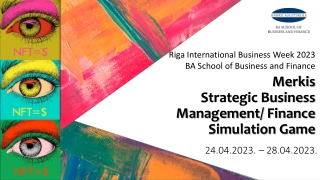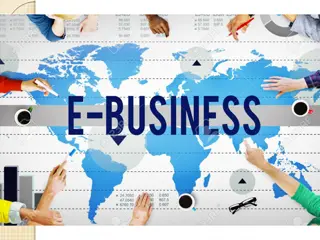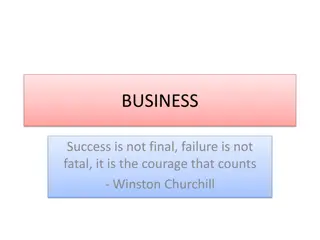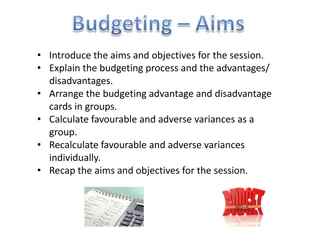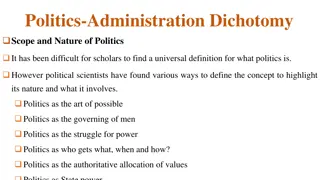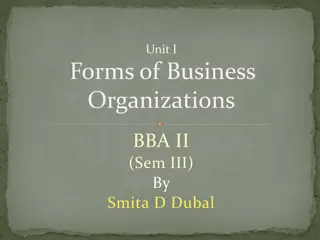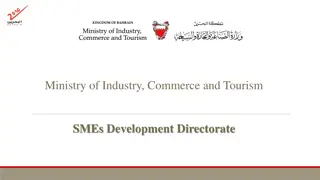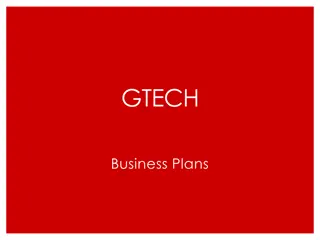Understanding E-Business: Definitions and Objectives
E-Business, encompassing electronic commerce, involves computer-mediated processes within organizations for profit, government, or non-profit. It enables online transactions and internal business operations through the internet, revolutionizing commercial activities. The objectives for e-business development arise from changing markets and organizational needs, leading to conflicts that impact system architecture. E-Business continues to evolve, playing an increasingly vital role in commercial transactions over the past three decades.
Download Presentation

Please find below an Image/Link to download the presentation.
The content on the website is provided AS IS for your information and personal use only. It may not be sold, licensed, or shared on other websites without obtaining consent from the author. Download presentation by click this link. If you encounter any issues during the download, it is possible that the publisher has removed the file from their server.
E N D
Presentation Transcript
E-business Defined E-Business (electronic business) is any process that a business organization computer-mediated organizations include any for-profit, governmental, or nonprofit entity. conducts network. over Business a Their processes include production-, customer-, and internal- or management-focused business processes.
Electronic commerce focuses on the use of information and communication technology to enable the external activities and relationships of the business with individuals, groups, and other businesses, while e-business refers to business with help of the internet. Electronic business differs from electronic commerce as it does not only deal with online transactions of selling and buying of a product and/or service but also enables to conduct of business processes (inbound/outbound operations, marketing and sales, customer service) within the value chain through internal or external networks. logistics, manufacturing & The term "e-business" was coined by IBM's marketing and Internet team in 1996
objectives for e-business Development The organization is facing market changes and the organization changes according to the markets. The objectives for the e-business development emerge from these changes and because the change is continuous, it brings new requirements for the e-business system. In addition, the history and legacy structures of the organization cause conflicts in the development when combined with the need for change. These fluctuating objectives and emerging conflicts bring certain consequences to the e-business system architecture development in the organization. The formation and description of this causal model can be classified as selective coding.. In summary, e-Business has been in the making for the past 30 years.After starting as a niche solution for certain businesses and communities, e- Business today is an expanding force accounting for a steadily increasing share of commercial transactions. Its full potential remains in the future. Now you know how e-Business came to be as important as it is.The next lesson is about the direction in which e-Business moving.
The history of e-commerce: A long and winding road When considering time itself, the history of e-commerce is fairly short, but for most of us, the idea of life without online shopping is virtually inconceivable. From groceries to diamonds to services to Enterprise Level Product Solutions, almost anything you can imagine can be purchased electronically. But where did it all begin,and how far will it go?
The history of e-commerce: 1960s 1980s For beginning just a short while ago, the history of e- commerce is dramatic.In 1969,CompuServe was the first major e-commerce company to be formed in the United States. Although it seems distant now, computer time- sharing services grew from email providers to facilitating tele-shopping in the 1970s. While the rest of us were just beginning to celebrate the wonder of cable television at the beginning of the 1980s, some tech savvy users formed the Boston Computer Exchange, which was a bulletin board system-based marketplace established to facilitate the sale or trade of used computers.This company was a trailblazer in crafting a fully automated, on-line auction and marketplace for general commerce.
For many years, e-commerce existed quietly, but in 1990, the first web browser, aptly named WorldWideWeb, was launched. Around this time, development of the internet kicked into high gear, going from the ability to display basic style sheets to the launch of Amazon and eBay within just a few short years. Needless to say, those two have become smashing successes as they evolved into massive e- commerce platforms, selling and enabling consumers to sell their own wares to others on a global scale, as well as to subscribe to items they need no more going to the store to purchase standard household goods. By the late 1990s,we were all getting too much email, and DVDs began to outpace VHS tapes as the preferred method of viewing films but that didn t last long. In 1997,we saw the launch of Netflix as the world s first online movie rental store. Building their reputation on the model of flat-fee unlimited rentals without due dates, late fees, shipping and handling fees or per-title rental fees, Netflix wittingly upped the customer service game of all would-be online merchants while turning the entertainment industry on its head. Just one year later, Paypal, in its first iteration as Confinity, entered the scene as a tool for transferring money. The company now functions as a bank that executes payment processing for online vendors, auction sites, personal, and commercial users. It s a service that allows their customers to send, receive, and hold funds in 26 currencies worldwide. Today, Paypal Holdings,and its subsidiary,Venmo are two huge names in the digital wallet game.
2nd MBA SEM 2 E BIZ UNDERSTANDING TYPES OF BUSINESS MODELS lecture
Global E-Business retail sales surged 25.7% in 2020 to $4.213 trillion. Five, ten, or even twenty years ago this probably seemed like an impossible number to reach. E-Business has exploded over the last few years and even with the end of the COVID-19 pandemic in sight,isn t expected to slow down. The digital shift is a very real trend and businesses not already online will need to break into the E-Business landscape sooner rather than later. Applying the right E-Business business model to the online store will be one of the first steps. Not taking the time to evaluate your business and understand your target market can be extremely detrimental and lead to thousands in wasted spend. Digital advertising, SEO, and content marketing are effective ways to drive traffic, revenue and help you realize a large ROI, but they won't be nearly as effective without a well-planned E-Business business strategy. Whether you re just starting to explore E-Business models or already have an established digital commerce venture and are looking to expand your online presence, it s important to know which model best fits your needs and requirements
Developing an E - Business strategy is a crucial piece for many organizations. A huge component of this is identifying your target market and understanding what your E - Business business model will be And thus let us First of all understand Types of Business Models
Types of Business Models Electronic commerce, or E-Business, is a business model that lets businesses and consumers make purchases or sell things online. There are six major E-Business business models: Business to Consumer (B2C) Business to Business (B2B) Business to Government (B2G) Business to Business to Consumer (B2B2C) Consumer to Consumer (C2C) Consumer to Business (C2B) 1. 2. 3. 4. 5. 6. We ll review each of these six business classifications in depth and dig into the five primary delivery models that you will need to consider when launching or expanding your online store.
Business to Consumer (B2C) As the name implies, business to consumer (B2C) is when a company markets its products or services directly to end users.It is the most widely known form of commerce. B2C E-Business is fairly straightforward. You complete a B2C transaction every time you purchase food from a grocery store, eat dinner at a restaurant, watch a movie at a theater, and get a haircut.You are the end user of the products and services these companies sell. In E-Business,there are five different B2C business models: Direct Sellers, Online Intermediaries, Advertising-based, Community-based, Fee-based. 1. 2. 3. MARKET PLACE MODEL 4. 5.
B2C Business Models Direct selling is the most common model. It is when consumers buy products from online retailers. 1. Online intermediaries are online businesses that bring sellers and consumers together and take a cut of each transaction made. 2. In the advertising-based model, information is given away for free and money is made from advertising on the site. 3. Facebook is an example of a community-based site that makes money from targeting ads to users based on their demographics and location. 4. Finally, the fee-based model involves companies that sell information or entertainment to consumers for a fee, like Netflix or subscription-based newspapers. 5.
Direct selling is the selling of products in a non-retail setting, for example, at home, online, or other venues that are not a store. It eliminates middlemen who are involved in distribution, such as wholesalers and regional distribution centers. Instead, products are sent directly from the manufacturer to the sales company, then to the rep or distributor, and finally to the consumer. Eg Amway, Vestige, Proveda Products sold via direct sales are not typically found in traditional retail locations. This means that finding a distributor or rep is the only way to buy them. It s important to note that direct selling doesn t equal direct marketing. In the first case, individual distributors or reps reach out to customers directly. Meanwhile, in the second case, a company markets directly to clients. Some direct marketing examples include emails, flyers, promotional letters, outdoor advertising, ads, phone calls, websites, and others. Direct selling characteristics Focus on building relationships first, not making sales. Keep consistent and detailed customer records. Be passionate and knowledgeable about your products. Build and maintain your networks Organize your sales environment. Improve your sales skills.
3rd lecture MBA SEM 2 E BIZ UNDERSTANDING TYPES OF BUSINESS MODELS
2 Market place model refers to an intermediary website where several sellers list their products. The businesses use this as their market place instead of having their own website. The customers may by a wide range of heterogeneous products at comparative rates under this model. Various business and service providers list themselves on the E commerce platform advertising their services/goods. Steps Involved 1. The E commerce site verifies the businesses who intend to be listed and advertises their offering on their website. 2. The E commerce site verifies the orders placed and despatches goods from its warehouse/supplier s warehouse/ connects the customer to the relevant professional. 3. The payment is received by the E commerce site, charges a commission for the online market place and pays the supplier for his product
Thus, In recent years, online B2C sales have been trending upward. Many traditional brick-and-mortar retailers have either been closing, or pivoting and adding in digital channels to their strategy as shoppers go online for the things they need. This hybrid approach is when companies have both a traditional brick-and- mortar presence and an online shopping platform. Many companies integrate these approaches with an omnichannel E-Business* strategy to maximize the customer experience. For example, some companies now let you order your products online and pick them up at one of their local stores. Many companies also allow customers to return products they bought online to local stores for a quick and easy refund or exchange. To implement the B2C E-Business model successfully, businesses must rely on having a platform that can be adjusted quickly and adapt to new customer needs without causing delays in service. *omnichannel E-Business means denoting or relating to a type of retail or any business which integrates the different methods of shopping available to consumers (e.g. online, in a physical shop, or by phone)
Examples Of Market Place Model Flipkart Flipkart started off with a direct-to-consumer model selling books and some other products, before turning to a marketplace model which connect sellers and buyers and expanding its catalogue. The sources of income to Flipkart include seller commission, advertisements, logistics and convenience fees. Just dial Justdial is India s search engine for local search market which initially started as a classified website but soon transformed into a local search engine. They used word-of-mouth strategy to advertise themselves. Focussing on local brands and small businesses, the company became famous among the masses. Urban Clap Urban Clap is a company that provides a variety of services of professionals and blue collar workers at the convenience of customers home. Once can hire electricians, yoga trainers, lawyers, engineers, chartered accountants, beauticians, photographers, interior designers, etc.
4th lecture MBA SEM 2 E BIZ UNDERSTANDING TYPES OF BUSINESS MODELS
Business to Business (B2B) As the name implies, business to business (B2B) is when a company markets its products or services directly to other businesses. Or simply saying - A website following the B2B business model sells its products to an intermediate buyer who then sells the product to the final customer. B2B E-Business can be broken down into two methodologies, vertical and horizontal. Vertically oriented businesses sell to customers within a specific industry. With a horizontal approach, you are selling to customers across a myriad of industries. Each approach has their own pros and cons, such as industry expertise and market depth (vertical) versus wide-spread market coverage and diversification (horizontal). Both can be a lucrative pathway, but your strategy will depend on your products and customers, so consider them carefully. Historically, B2B businesses had always been a few steps behind their direct-to-consumer counterparts, especially when it came to commerce innovation and digital sales. The problem lay in price negotiation and collaboration, and many businesses were used to leveraging sales representatives as the primary revenue generating channel. BUT The modern B2B buyer has gotten quite tech savvy though, and now shares many of the same demands and buying habits as the average buyer. Convenience, flexibility, personalization, and integrated experiences are expected and now business-critical. Despite the slow adoption of digital strategies, B2B brands have focusing more and more on E-Business to keep up with consumers. A recent report by Gartner uncovered a recent dramatic shift with B2B digital commerce initiatives surpassing B2C. Gartner assumes "By 2025, 75% of B2B manufacturers will sell directly to their customers via digital commerce."
Top Trends In B2B E-Business B2B E-Business has rapidly been changing over the past few years, and 2021 is no exception. With the disruption of COVID-19, new trends have emerged, and the E-Business landscape is transforming. B2B companies are implementing new strategies to adapt to a changing market and take advantage of a growing online customer base, characterized by rising mobile usage, new expectations for personalization and .self-service, and increasing demand for digital connectivity. 1) M-Commerce is on the rise: Mobile has continued to transform the B2B landscape, with more and more consumers demanding seamless, aesthetic, and flexible mobile experiences. Rather than simply comparing product offerings and services across businesses in an industry, consumers are increasingly comparing the digital experiences they have had and have come to expect. Google recently partnered with The Boston Consulting Group (BCG) to research how mobile has been impacting B2B customers and organizations.Key data shows that: Mobile influences an average of over 40% of revenue in leading B2B organizations. 50% of current B2B search queries are made on smartphones, with BCG expecting that figure to grow to 70% by 2020. Daily mobile usage per B2B worker is expected to increase from 2 hours to 3 hours, driven by millennials, Gen Z, and the increasing use of smartphones by older workers. More than 90% of B2B buyers reporting a superior mobile experience claim that they would be more likely to repurchase from the same vendor, while only 50% claim so when reporting a poor mobile experience.
As of 2021, mobile has continued to expand and proliferate the B2B eCommerce space, and its growth will likely extend over the coming years. B2B marketers must boost their mobile efforts to capitalize on this rapid trend. Here are 5 calls to action for businesses hoping to accelerate their mobile integration: 1. 2. 3. 4. 5. Track buyer experiences across media and devices Invest into building visual and frictionless mobile experiences for customers Adapt data collection to a company s business model and size Increase mobile advertising while adjusting marketing strategies based on results Simply the B2B purchase process on mobile, de-emphasizing text in favor of rich media
Top Trends In B2B E-Business 2) Customers are showing a preference for Digital Self-Service. B2B buyers increasingly desire control over their eCommerce experiences, with a strong preference for self-service; seamless shopping experiences in their personal lives have shaped their B2B buying expectations. The COVID-19 pandemic has further pushed B2B sales towards self-service, and research shows that digital self-service will likely remain a dominant element of the B2B go-to- market model. A report published by McKinsey & Company earlier this year detailed results from a global survey, highlighting key takeaways for B2B businesses aiming to adapt their practices in the wake of the pandemic. Results show that: When asked what kind of interaction was most helpful in choosing a supplier, 47% of respondents preferred some form of online self-service. 25% chose supplierwebsite , while 22% selected online material from supplier . When asked what ordering method they preferred, 46% of respondents chose using a supplier s website . When asked How do you currently interact with sales reps from your company s suppliers during the 4 stages of interaction , an average of 34% of respondents chose digital self-service for the Research, Evaluation, Ordering, and Re-Ordering stages. In comparison, results for 2020 showed an average of only 29% for self-service across all 4 interaction stages, with a 12% increase for self- service in the Research and Evaluation stages. 83% of B2B decision makers feel that the new selling models emphasizing remote interactions and online self-service are as effective as or more effective than pre-COVID-19 models that prioritized direct interactions. 87% of B2B decision makers believe that these shifts in selling models will likely sustain 12+ months after the COVID-19 pandemic. 1. 2. 3. 4. 5.
Top Trends In B2B E-Business 6. Digital self-service has become the new normal , dominating the B2B buyer journey and driving B2B manufacturers towards implementing customer self-service portals. Here are 5 calls to action for B2B organizations hoping to re-engineer their sales efforts towards digital self-service: Integrate eCommerce catalogs with rich media, including photos, videos, interactive content, product comparison features, and various self-service tools to support the research and evaluation stages. 1. Provide responsive interfaces and intuitive commands that help buyers save time during the ordering and re-ordering stages. 2. Implement customer self-service portals with the optimal ERP-integrated solution, enabling post-order care that supports independent tracking, invoices, and payment. 3. Adopt an Agile approach and apply it to self-service digital solutions, empowering adaptability, flexibility, and speed when the digital transformation process. 4. Incorporate the voice of the customer while developing self-service digital solutions, gathering feedback to address customer needs and realize requirements prior to rollout. 5.
Top Trends In B2B E-Business 3) Omnichannel Experiences are the new standard: When given the choice of in-person, remote, and e-commerce channels, buyers have expressed the desire for all three. Omnichannel retailing has become a cornerstone of global B2B sales, establishing itself as the new standard, not the exception. The COVID-19 pandemic has anchored omnichannel interactions in B2B sales, with businesses realizing the importance of omnichannel to centralize various sales channels and customer relationships together. The rise of M-Commerce and mobile, increased social media engagement, and consumer s growing affinity for self-service have all emphasized the importance of B2B businesses establishing a cohesive omnichannel experience. McKinsey published a report earlier this year highlighting the growing impact of omnichannel on B2B sales.Data shows that: Approximately 80% B2B leaders say that omnichannel is as or more effective than traditional methods 83% of B2B leaders believe that omnichannel selling is a more successful way to prospect and secure new business than traditional sales approaches 85% of US B2B leaders claimed that new omnichannel-based sales models were equally as effective or more effective than previous sales models, indicating a 43% increase compared to the previous year 20% of B2B buyers said that they would be willing to spend more than $500,000 in a fully remote/digital sales model 64% of B2Bs intend to increase the number of hybrid sellers over the next six months 85% of B2Bs expect hybrid sellers will be the most common sales role in their organization over the next three years 1. 2. 3. 4. 5. 6.
Top Trends In B2B E-Business To effectively capitalize on the expansion of omnichannel and maximize its power, B2B organizations must first overcome some key challenges and pain points. Investment into effective infrastructure, facilitating hybrid selling, and adapting to remote operations are all important steps. Here are 3 calls-to-actions: Make remote interactions feel intimate, genuine, and effective, providing proofs of concept, digital demos, and clear visual representations that provide an equal or superior level of insight to physical walk-throughs. 1. Innovate sales approaches using customer feedback, data, and consumer insights to ensure that digital transactions are not a zero-sum game. 2. Adopt an Agile approach to facilitate quick and improved pivoting of resources 3.
Business to Government (B2G) Business to government (B2G) is when a company markets its products and services directly to a government agency. This agency could be a local, county, state, or federal agency. An example of a B2G relationship is when an ammunition manufacturer sells ammunition to the US Army. And an example of a local B2G relationship is when a private engineering company sells its engineering services to a county government to develop a new water and sewer system for the community. In B2G, companies typically bid on projects when governments announce Requests for Proposals (RFPs). Interacting with government agencies is very different from working with other businesses or consumers. Due to having to deal with bureaucracies, business deals tend to move at a much slower pace than in other sectors. Ecommerce companies can definitely bid on government contracts, the same as other companies.
Business to Business to Consumer (B2B2C) In B2B2C ecommerce, a company sells products to another company which are then sold to consumers. An example of a B2B2C arrangement is when a wholesale distributor sells merchandise to retail stores that then sell the merchandise to end users. The B2B2C model is comprised of three parts: the first business (the business of product origin), an intermediary, and the end user. There are several different ways the B2B2C model can be used in eCommerce applications. For example, a company could partner with another company to promote its products and services, giving the partner a commission for each sale. The primary advantage of the B2B2C business model for eCommerce companies is the acquisition of new customers. This is an important consideration for new eCommerce companies that need a way to rapidly grow their customer base.
How Does B2B2C eCommerce Work? The B2B2C business model has three members. Business A establishes a mutually beneficial business deal with Business B to bring a better choice of products to Consumers and provide a higher level of customer experience at Business B s ecommerce website. Let us quickly look into the reason for each party in this chain. B2B2C Meaning: First B Is Business "A" in B2B2C This means an original business that enters the B2B2C collaboration and has a hope to acquire more consumer customers. In the classical market model of channel partnership, Business "A" has to find a wholesale buyer, such as a distributor or a retail chain, and establish trade relations with them to sell Business A s goods to retail buyers at the last stage of the sales channel.
How Does B2B2C eCommerce Work? The advantage of B2B2C model in ecommerce is that Business A s products immediately fall into the view of Business B s customers at Business B s ecommerce website, bypassing the intermediate stage of wholesale, resale between companies, and other intermediate stages. Moreover, orders placed online in Business B s online store can be delivered to consumers directly from Business "A", i.e., Business "A" could have direct access to customers if it is allowed by an agreement with Business B . This model is especially effective for the small biz niche and emerging brands that can take advantage of Business B s popularity and reputation.
B2B2C Meaning: Second B Is Business "B" in B2B2C An intermediate Business B can have several possible motives to participate in the B2B2C model. On the one hand, it might just be commercial considerations; for example, the second B might get the sales commission that is funnelled through it. But often the middle B doesn't make too much money in this chain. Therefore, there must be other motives as well. Some of these involve providing value to Business "B" customers by giving them better (or more convenient) buying options. For Example - Buying a school uniform,/ Text Books middle B is likely to want to ensure that all of their customers buy a standardized and desired product at one platform.




